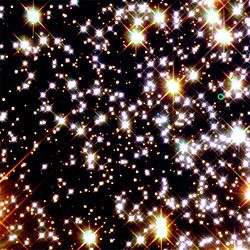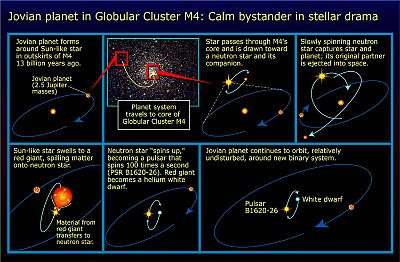PSR B1620-26
 The location of PSR B1620−26 (circled) | |
| Observation data Epoch J2000.0 Equinox J2000.0 | |
|---|---|
| Constellation | Scorpius (M4) |
| Right ascension | 16h 23m 38s |
| Declination | −26° 31′ 53″ |
| Apparent magnitude (V) | +24 |
| Characteristics | |
| Spectral type | Pulsar / DB |
| U−B color index | ? |
| B−V color index | ? |
| Variable type | none |
| Astrometry | |
| Radial velocity (Rv) | ? km/s |
| Proper motion (μ) | RA: ? mas/yr Dec.: ? mas/yr |
| Parallax (π) | ? ± ? mas |
| Distance | 12,400 ly (3,800 pc) |
| Absolute magnitude (MV) | ? |
| Details | |
| Mass | 1.35 / 0.34 M☉ |
| Radius | ? R☉ |
| Luminosity | ? L☉ |
| Temperature | ? K |
| Metallicity | ? |
| Rotation | ? |
| Age | ? / 1.3 × 1010 years |
| Other designations | |
PSR J1623−2631, 16:23:38.22−23:31:53.8 J2000, 16:23:38.24−26:31:53.9, ICRS 2000 | |
PSR B1620-26 is a binary star system located at a distance of 3,800 parsecs (12,400 light-years) in the globular cluster of Messier 4 (M4, NGC 6121) in the constellation of Scorpius.[1][2][3] The system is composed of a pulsar (PSR B1620-26 A) and a white dwarf star (WD B1620-26 or PSR B1620-26 B). As of 2000, the system is also confirmed to have an extrasolar planet orbiting the two stars.
History
The double system (triple including the substellar companion) is just outside the core of the globular cluster. The age of the cluster has been estimated to be about 12.2 billion years.[4] Hence this is the age estimate for the birth of the planet, and two stars.
There is a minor dispute about the proper nomenclature rules to use for this unusual star system. One side regards the A/B convention of naming binary stars as having priority, so that the pulsar is PSR B1620-26 A, the white dwarf companion is PSR B1620-26 B and the planet is PSR B1620-26 c. The other side considers PSR to apply only to stars which are pulsars, not their companions, so the white dwarf should be named using the WD convention, making the pulsar PSR B1620-26, the white dwarf "WD J1623-266", and the planet "PSR B1620-26 b." Early articles used the first convention, but star catalogs have been using the second.[5][6] The most recent proposal[7] provides a nomenclature like PSR B1620-26 (AB)b, including capital letters A and B in parentheses to identify inner stellar components of binary system, followed by italic letter b referred to outer planetary companion. In practice, context makes it clear whether the pulsar, the white dwarf, the planet, or the system as a whole is being referred to.
White dwarf
The mass of the white dwarf is 0.34 solar masses; both orbit at an inclination of 55°.[8]
Planetary system

PSR B1620−26 b was originally detected through the Doppler shifts its orbit induces on signals from the star it orbits (in this case, changes in the apparent pulsation period of the pulsar).
In the early 1990s, a group of astronomers led by Donald Backer, studying what they thought was a binary pulsar, determined that a third object was needed to explain the observed Doppler shifts. Within a few years, the gravitational effects of the planet on the orbit of the pulsar and white dwarf had been measured, giving an estimate of the mass of the third object that was too small for it to be a star. The conclusion that the third object was a planet was announced by Stephen Thorsett and his collaborators in 1993.
| Companion (in order from star) |
Mass | Semimajor axis (AU) |
Orbital period (days) |
Eccentricity | Inclination | Radius |
|---|---|---|---|---|---|---|
| b | 2.5 ± 1 MJ | 23 | ~36,500 | low | 55-8+14° | — |
See also
References
- ↑ Jean Schneider (2011). "Notes for star PSR B1620-26". Extrasolar Planets Encyclopaedia. Retrieved 26 September 2011.
- ↑ Z. Arzoumanian; K. Joshi; F. A. Rasio; S. E. Thorsett (1999). "Orbital Parameters of the PSR B1620-26 Triple System". Proceedings of the 160th colloquium of the International Astronomical Union. 105: 525. arXiv:astro-ph/9605141
 . Bibcode:1996astro.ph..5141A.
. Bibcode:1996astro.ph..5141A. - ↑ "Messier 4 (M4) globular cluster". European Southern Observatory. 2009. Retrieved 26 September 2011.
- ↑ Caputo, F.; Castellani, V.; Quarta, M. L. (February 1985). "Reddening, distance modulus and age of the globular cluster NGC 6121 (M4) from the properties of RR Lyrae variables". Astronomy and Astrophysics. 143 (1): 8–12. Bibcode:1985A&A...143....8C.
- ↑ WD J1623-266 at SIMBAD
- ↑ Jean Schneider (2011). "Notes for Planet PSR B1620-2 b". Extrasolar Planets Encyclopaedia. Retrieved 24 September 2011.
- ↑ F.V. Hessman; V. S. Dhillon; D. E. Winget; M.R. Schreiber; et al. (2010). "On the naming convention used for multiple star systems and extrasolar planets": 4. arXiv:1012.0707v1
 . Bibcode:2010arXiv1012.0707H.
. Bibcode:2010arXiv1012.0707H. - ↑ S. Sigurdsson; H. B. Richer; B. M. Hansen; I. H. Stairs; et al. (2003). "A Young White Dwarf Companion to Pulsar B1620-26: Evidence for Early Planet Formation.". Science. 301 (5630): 193–196. arXiv:astro-ph/0307339
 . Bibcode:2003Sci...301..193S. doi:10.1126/science.1086326. PMID 12855802.
. Bibcode:2003Sci...301..193S. doi:10.1126/science.1086326. PMID 12855802.
External links
Coordinates: ![]() 16h 23m 38s, −26° 31′ 53″
16h 23m 38s, −26° 31′ 53″